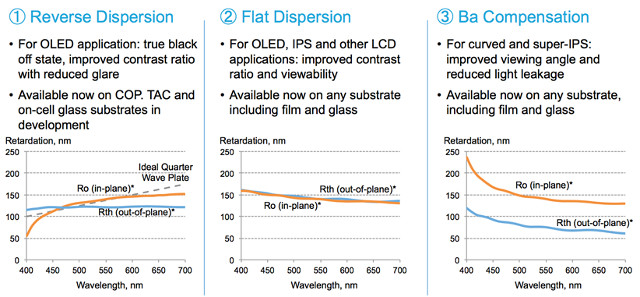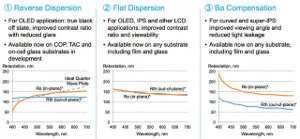Light Polymers releases LCD and OLED compensation nano-materials coatable directly on on-cell glass which provides flat panel makers with another option to implement compensation coatings.
Compensation films are typically used in LCDs to reduce the color shift and light leakage that occurs when viewing the display at angles. Some of these films can also be used in OLED displays to get a deeper black color in the off state and improve the contrast ratio, or to make both LCD and OLED displays viewable while using polarized sunglasses. The new lyotropic liquid crystal compensation materials are coatable on glass and offer a range of compensation properties including -C, +A and Ba. Combinations of these materials allow for complex compensation plates and accommodate a range of LCD modes such as IPS/FSS.
On-glass coatings (1 micron or less ) provide an alternative to optical films for compensating LCD and OLED displays. Display panel manufacturers now have the option of using a coating directly on their display panel, which can reduce the overall stack thickness and increase the OLED and LCD flat panel makers design control and increases vertical integration.. Light Polymers’ nano-materials are tunable to meet a flat panel maker’s exact needs.
Compensation films are often characterized by their in-plane and out-of-plane retardation, Ro and Rth respectively. Ro affects light travelling at normal to the LCD plane. A combination of Ro and Rth affects light traveling at all other angles, and the further this angle is from the normal, the more Rth plays part. Light Polymers materials allow great flexibility in Ro and Rth absolute and relative values as well as their wavelength distributions, allowing panel makers to design displays with higher contrast and wider viewing angles.

As demonstrated in Figure 1, currently available Light Polymers materials allow ? reverse (increasing Ro), ? flat (flat Ro) or ? normal (decreasing Ro) dispersions of in-plane retardation, which is unique in allowing the LCD manufacturers to not only choose the Ro and Rth values, but also their distribution over the wavelength. These materials can be combined for greater flexibility.
“The flexibility of Light Polymers materials allows for simple customization of the retardation solution to the panel manufacturer’s needs,” according to Sergey Fedotov, technical product manager. “There is no need to adjust equipment or process. We formulate to customer’s specification and if any adjustments need to be made, they happen at the formulation stage.”
When traditional stretched films are laminated to thin glass (under 0.5mm now), they induce stress and cause optical artifacts. With Light Polymers’ nano-materials coated directly on glass at 1 micron or thinner, there is no stress induced in the thinner glass.
“This is a breakthrough for the compensation film industry,” noted Marc McConnaghey, President/CEO of Light Polymers, Inc. “With an industry standard slit coater, we enable the panel manufacturers to bring optical compensation in-house, allowing for thinner displays, reduction in costs and shorter lead times.”
Light Polymers is currently qualifying coating equipment manufacturers for implementing lyotropic liquid crystal materials in production. Light Polymers will be showcasing its solutions at SID DisplayWeek 2015 in San Jose from June 1-5, 2015.

